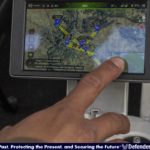The 9th SFS is taking security capabilities thinking outside the box.
Staff Sgt. Francis Arnaldo, 9th Security Forces Squadron resource protection noncommissioned officer in charge, flies a drone while testing out the Hivemapper program capabilities at Beale Air Force Base, Calif., April 12, 2019. The Hivemapper program is a three-dimensional drone that can map infrastructure while providing visualization and analytic tools. (U.S. Air Force photo by Tech. Sgt. Veronica Montes)
BEALE AIR FORCE BASE, Calif. (AFNS) —Saving time and money, reducing manpower, increasing security, improving mission effectiveness and innovating are all priorities articulated by senior leaders regarding the Air Force we need. These priorities are coming to fruition from a partnership between intelligence and security agencies.
Beale AFB is currently the first base to beta-test the Hivemapper program, an artificial drone capability that records and senses change detection, as a way to save time and manpower, while improving security and operational risk measures for the installation.
“What we are doing is taking intelligence capabilities and thinking outside the box,” said Master Sgt. Nathaniel May, 9th Intelligence Squadron operations superintendent. “We are partnering our intelligence capabilities with other base agencies. Instead of using this ability strictly in an austere environment, we can now also use it locally to benefit home station operations.”
The Hivemapper program is an eye in the sky that can map infrastructure while providing visualization and to enhance analytic tools. The imagery recorded can uncover changes the human eye cannot easily detect. While this capability could be beneficial to multiple wing units, the 9th Security Forces Squadron is teaming with members from the 548th Intelligence, Surveillance and Reconnaissance Group to test this initiative.
“This ability could save Airmen time in conducting routine perimeter security checks and also provide the ability to maintain a digital log to review later,” said Master Sgt. Ajenna Smith, 9th SFS innovations superintendent. “This program could also show changes in terrain. For example, if a hole or tunnel is dug from the outside of the perimeter, the Hivemapper system has the ability to detect and flag those land changes.”
According to May, this program is just one of the few programs the 9th SFS is trying to implement in order to stay one step ahead of adversaries and to innovate for the future.
Because of its change detection abilities, this technology could be used by base civil engineers for construction and maintenance imagery. The implications could expand to use by a number of career fields and base agencies.
The partnership between Hivemapper members and Beale AFB began at the end of 2018 and has since been ongoing and growing. May, along with members from his innovation team, frequent Hivemapper’s headquarters in San Francisco.
Even since the partnership’s inception, Will Urbina, Hivemapper head of flight operations, said improvements and updates to the program had continuously enhanced imagery collection. These updates have brought a clearer vision to the program and more in-depth change detection capabilities.
“The Air Force is driving the future of ISR and Hivemapper is proud to be part of that,” said Ariel Seidman, Hivemapper chief executive officer. “With deployments across the Air Force, the Air Force Research Laboratory and Air Force Special Operations Command to name a few, the Hivemapper team continues to learn and grow with the Air Force to deliver capabilities in demand by Airmen in the field.”
The three-dimensional airborne video map program also has safety and recovery functions which are already being used in the civilian sector. With the growing partnerships, May noted this innovative approach is something that could have a positive effect on Beale. Based off how testing evolves locally, the team would like to see this innovative approach adopted at other installations.
“This could lead to a great capability for the Air Force, but sharing these best practices could reach even further. Our long-term vision would be to have this benefit the entire Department of Defense,” May said.
Staff Sgt. Francis Arnaldo, 9th Security Forces Squadron resource protection NCO in charge, points to Hivemapper drone imagery taken at the perimeter of Beale Air Force Base, Calif., April 12, 2019. Beale AFB is currently the first base to beta-test the Hivemapper program, a drone capability that records and senses change detection. (U.S. Air Force photo by Tech. Sgt. Veronica Montes)

